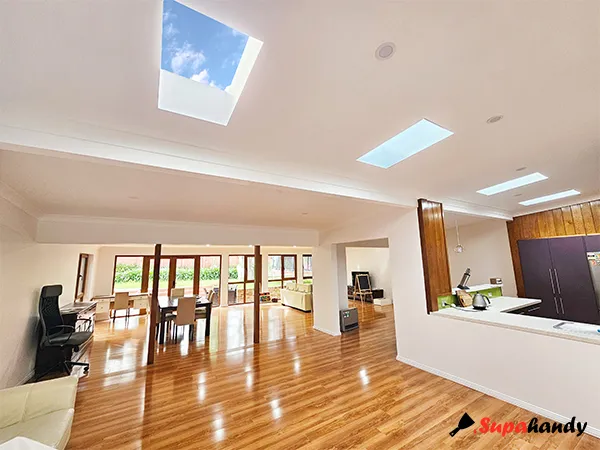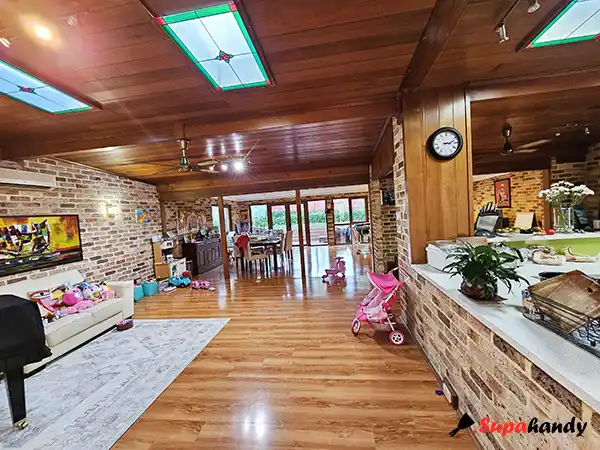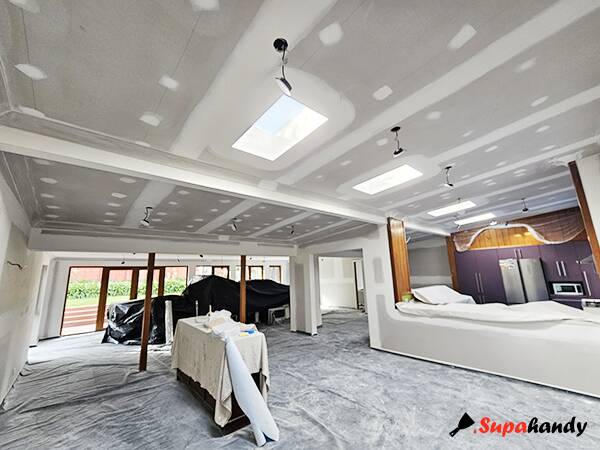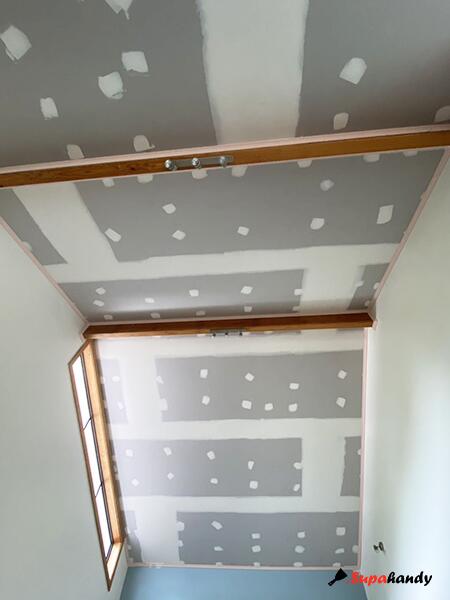Introduction
Homeowners often struggle to decide whether to keep or replace their wooden ceiling.
Some people choose to cover their wooden ceiling with plasterboard and paint it white for a fresh look. Others wonder if removing the wooden planks before installing new plasterboard is a better option. Many also ask whether they can simply paint a dark timber ceiling white or how to enhance the natural beauty of the wood.
These are common questions, whether you’ve just moved into an older home with a timber ceiling or have had lived under the timber ceiling for years.
If you’re considering changing an orange or dark ceiling to white or a lighter, more neutral shade, this article will guide you through your options and help you decide whether to keep or replace your wooden ceiling.

Why the Popularity of Wood Ceilings in the Past
Many homes have dark timber plank ceilings, often in cedar tones. This trend was especially popular in Sydney, Australia, about 20 to 30 years ago when shiplap-style wooden ceilings were in fashion. Their popularity came from their many benefits:
- They are versatile, fitting various design aesthetics.
- They are durable and long-lasting, and can stand the test of time.
- Wood is a natural insulator, regulating temperature and reducing energy costs.
- Wood also has acoustic benefits, reducing echo.
- Maintenance is quite easy, requiring only occasional dusting or polishing.
- Wooden ceiling definitely adds big value to a home.
- It is an eco-friendly choice and renewable.
- Customization options abound, allowing for a personalized look.


Reasons for Replacing the Timber Ceiling
In recent roof renovation projects, we came across several homes with wooden ceilings. The homeowners had lived with them for over 10 years and were set on replacing them with white plaster ceilings. At first, I was unsure about their decision since the ceilings were still in good condition.
The homeowners appreciated the eco-friendliness, durability, and value of wooden ceilings. However, after discussing further, I understood their decision. Their main concern was that the ceilings had become too dark and had lost their clean, polished look.
The homeowners wanted to brighten their rooms and create a more modern feel, possibly by adding contemporary cabinets and furniture. This shows that while wooden ceilings have their benefits, changing design preferences play a big role in decision-making. The desire for a fresh, modern space can lead homeowners to replace their ceilings, even if they’re still in good condition.


Deep Analysis of Replacing Timber Ceiling
Coincidentally, two clients had similar wooden ceiling situations. Their slanted ceilings have a lowest point of about 2.4 to 2.5 meters, with solid wood planks in deep, warm tones—one resembling cedar and the other a golden hue. In the lower areas, the wood’s details are more noticeable, but they appear dull and slightly greasy, especially in the kitchen. The ceilings also feature messy black knots, uneven yellowish tones, and a pronounced texture.
The owners want to give their ceilings a fresh new look by replacing the old spotlights, downlights, and skylights. One owner also plans to update their outdated yellow solid wood kitchen cabinets to create a modern kitchen. The yellow, “outdated” shiplap-style ceiling is the first step in renovating their spaces.
Personally, I feel that wooden-style ceilings might be “overused” in these two homes. The rustic look of the wooden ceiling, along with the uneven color between each plank, may not be ideal for rooms with relatively low ceilings. This is especially true for kitchens, where oil fumes are common and require frequent cleaning, or for bedrooms that prioritize tranquility, warmth, and a clean, calming atmosphere.
On the other hand, wooden ceilings are well-suited for high-ceiling areas like stair halls, large public spaces, and grand auditoriums with ceilings over 4 or 5 meters. The height can help conceal some of the imperfections in the wood’s details. Genuine solid wood planks with a glossy clear oil finish can truly highlight the elegance and grandeur of these rooms. In such spaces, when faced with the question of whether to “keep the natural timber plank ceiling or replace it?”, the answer is usually to “keep it.” Regular maintenance, including cleaning and varnishing, is the best approach to preserving its beauty.
Detailed Solutions for Keeping or Replacing Timber Ceiling
Is it best to remove the wooden planks before screwing up new plaster boards?
Many people ask whether it is necessary to remove the old wooden ceiling before re-nailing the plasterboard. The answer depends on the actual situation.
According to experience, if the old wooden ceiling panel is strong enough to bear a new plasterboard, like it’s solid hard wood panel, or the panel thickness is more than 18mm (as to this part, it’s necessary to allow experienced trades double check onsite), and there are no decay and breakage issues, the plasterboard can be nailed onto the wooden ceiling straightway. Before nailing the plasterboard, reinforce the solid wood panel to the ceiling joints or battens with screws. If unsure, use an electronic stud finder to locate the joints or battens. Then, secure the new plasterboard with long screws into the timber joints or battens of the ceiling.
In addition, some people may worry about the fireproof problem of the practice of adding a layer of plasterboard on the wooden ceiling. Think about it, doesn’t the wooden ceiling have a fireproof problem?
As the homeowner, if you plan to remove the wooden ceiling and install new plasterboard over the beams or joints, that’s a viable option. The advantage is that you can clean the dust behind the ceiling board and add or replace new insulation. Also, should you need to remove the ceiling in the future, you’ll only have to remove one layer instead of two. The disadvantage is that you will incur the cost of removing the old ceiling. In some cases, the installer before you may have used glue as an auxiliary fixing method when installing the old wooden ceiling, which will require some labor to clean up. Furthermore, based on experience, a single layer of plasterboard is not as strong as two layers of boards, especially one layer of timber boards.
How to brighten the dark color timber ceiling?
Can the timber ceiling be repainted by ceiling white rather than being removed? White paint is also an optional solution, as long as you can accept the texture of the wood, the groved seams where the boards connect, and some inherent flaws in details on the boards.
Under normal circumstances, it is necessary to use a stain blocker or oil-based primer to lock the color of the clear oil, and then apply 1 – 2 layers of normal ceiling finish paint to achieve the expected effect. You can read Water or Oil-based Paint: Which is Right for your Woodwork Painting to help to choose the right paint.

What do with the exposed timber beam and rafters?
Solid wood ceilings often feature exposed beams and rafters for decoration. We recommend preserving these elements instead of covering them with plasterboard. A fresh coat of stain and varnish can restore their luster.
However, if you prefer, you can still cover them. It all depends on personal preference.
But one thing must be clear: uncovering beams later will be costly if adhesive was used. Because in most cases, when fixing the plasterboard, acrylic stud adhesive is usually used as an auxiliary fixing means. And it is more difficult to clean up this glue than to disassemble the plasterboard. So, it’s better to tell a plasterer or builder to use screws as the only fixing method rather than acrylic glue as an assistant fixing method, if you may want to expose these beams in future.
In conclusion, the choice between replacing or keeping a wood ceiling hinges on various factors.
For the clients with low, dark or deep color wooden ceilings, options like plasterboard covering or repainting were explored in this article. Double sheet Plasterboard on timber ceiling or removing and install new plasterboard all have pros and cons, or just repainting can retain character. As discussed, treatment of timber beams also has alternatives. Homeowners must weigh aesthetic, functional, and long-term aspects. Balancing the urge for change with the value of the existing ceiling is key to making the optimal choice for each distinct situation and enhancing the interior’s overall quality.
